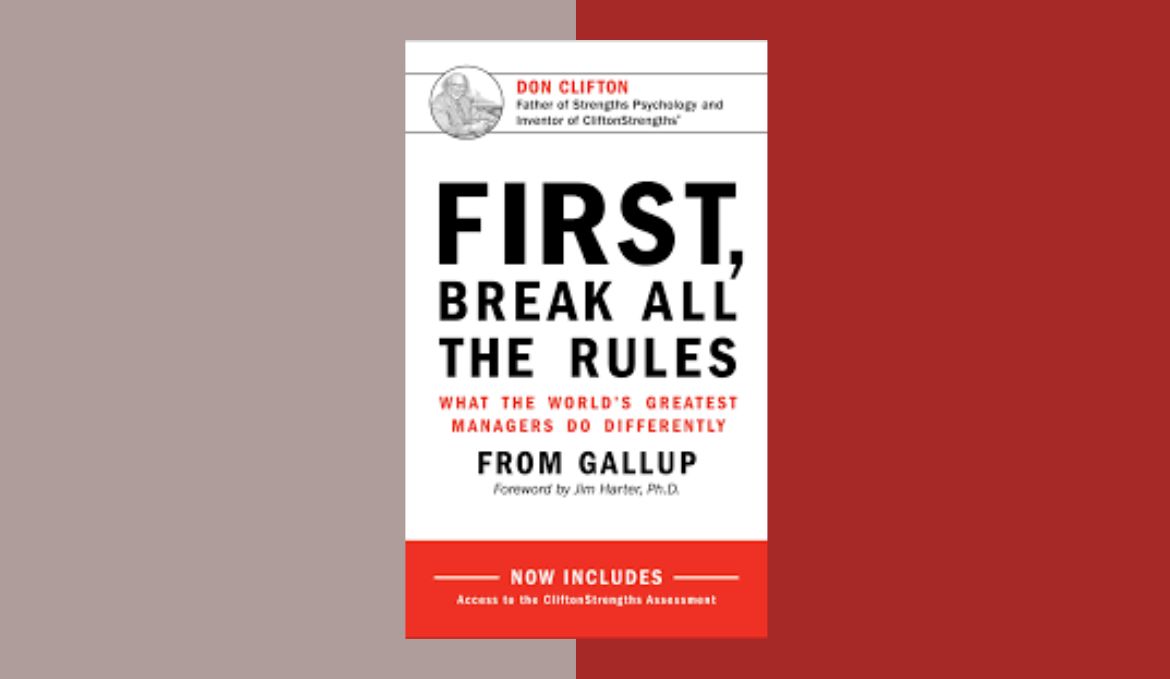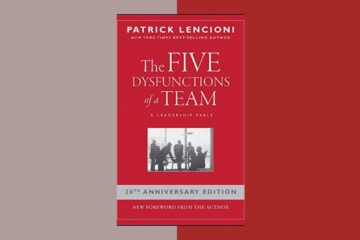Anyone interested in managing people should read First, Break All the Rules by Curt Coffman and Marcus Buckingham. This breakthrough book questions standard management approaches and proposes a fresh approach to directing teams based on employee strengths and skills.
The authors determined the 12 critical questions that the greatest managers ask themselves to build high-performing teams after interviewing over 80,000 managers in various sectors. The authors’ four keys to excellent management—talent selection, outcome definition, strength focus, and fit—are based on these questions.
The book claims that great managers focus on team members’ strengths rather than faults. They encourage employees to learn and use their strengths to succeed. They understand that each individual is unique and demands a different management style.
The authors offer guidance on interviewing, performance management, and team building to execute their strategy. The book’s lessons apply to all managers, from front-line supervisors to executives, in all types of organizations, from tiny firms to major multinationals.
First, Break All the Rules is an insightful and thought-provoking book that challenges established management techniques and offers a new approach to building high-performing teams. Its realistic counsel and tangible tactics are invaluable for aspiring managers.
The Measuring Stick
The writers Curt Coffman and Marcus Buckingham examine the necessity of evaluating employee satisfaction and engagement in the first chapter of the book titled “The Measuring Stick.” In this chapter, the authors focus on the value of measuring employee satisfaction. They start off by telling the account of a shipwreck that occurred off the coast of the Scilly Isles due to a lack of appropriate measurement instruments. This serves as an illustration of how crucial it is to have the appropriate tools to measure what is important.
The writers present the notion of the “12 Questions,” which are a measuring stick for employee engagement and satisfaction. The authors established the concept of the “12 Questions” via considerable study, and they are introduced by the authors. The writers then investigate the subject of how human capital might be measured, and they describe each of the 12 questions in some length.
The authors then on to discuss how they put the 12 questions to the test in a variety of businesses and found that there was a connection between the results of those businesses and the questions. They utilize a case study to explain how the 12 questions can be applied to improve employee engagement and business outcomes in a specific company. The purpose of the case study is to demonstrate how the questions can be used.
The authors conclude by discussing the significance of the order in which the 12 questions are presented and why this is important. They say that the order of the questions is crucial because it helps to generate momentum and gets employees thinking about their participation in a certain way. This is because the order of the questions can be found here. In general, the first chapter lays the groundwork for the rest of the book by highlighting how important it is to measure the level of employee engagement and providing a framework for how to go about doing so.
The Wisdom of Great Managers
The writers Curt Coffman and Marcus Buckingham draw on their research at Gallup to identify the main attributes and behaviors of outstanding managers in chapter 2 of “The Wisdom of Great Managers.” F1 The chapter is titled “The Wisdom of Great Managers.” The writers begin by emphasising the importance of listening to and valuing the ideas of employees by giving statements from managers who have been acknowledged as excellent by their employees. The employees have recognized these managers as great.
The authors then provide the paradigm-shifting realization that all effective managers have in common: rather than concentrating on making up for deficiencies, great managers play to the strengths of their employees. The authors contend that effective managers understand how to capitalize on the one-of-a-kind skills and assets possessed by their workforce, rather than attempting to transform their workers into someone they are not already.
The writers then proceed to discuss the four fundamental responsibilities that excellent managers have, which are to choose employees, to set expectations for employees, to motivate employees, and to develop people. They say that excellent managers are exceptional in each of these tasks and are able to customize their approach to the specific needs of each individual worker.
The final point that the authors make is that outstanding managers are able to fulfill various roles because they concentrate on the outcomes, treat each employee as an individual, spend their time doing the things that are most important, and cultivate good connections with their people. This chapter not only gives a framework for understanding what successful managers do differently, but it also establishes the foundation for the in-depth investigation of these ideas that will be found throughout the rest of the book.
The First Key: Select for Talent
In Chapter 3, “The First Key: Select for Talent,” the topic of the significance of selecting potential employees based on their inherent abilities and strengths in relation to the needs of the position is discussed. The authors contend that the first element to effective management is to hire people based on their talent.
In the beginning of the chapter, a definition of talent is presented. Talent is described as a natural ability or propensity toward particular activities or behaviors. The writers claim that in order to perform a function to the best of one’s abilities, it is necessary to possess talent regardless of how difficult the role may be.
When it comes to doing a profession at a high level, the writers continue by explaining that talent is more vital than experience, intelligence, or willpower in order to achieve one’s goals. Experience and intelligence are both necessary for success in a function, but neither one is sufficient on its own to guarantee success in the role. Instead, the authors recommend that effective managers should center their attention on recruiting staff members whose innate skills and capabilities are a good match for the requirements of the position.
The writers also emphasize the significance of determining the exact skills that must be possessed by a candidate in order to fulfill a given function, as well as devising a method for locating and selecting individuals who already have such skills. They say that outstanding managers should focus on finding the proper fit for the work rather than trying to train employees to execute duties that do not correspond with their natural skills. This is because training employees to perform things that do not align with their natural talents can be counterproductive.
In general, this chapter emphasizes how important it is to choose people based on their natural abilities and strengths, as opposed to depending exclusively on experience or intelligence when making hiring decisions. Great managers are able to establish a team of employees that are well-suited to their tasks and who are able to perform to the best of their abilities by following these steps.
The Second Key: Define The Right Outcomes
In the fourth chapter of “First, Break All the Rules,” the topic of “defining the right outcomes” is discussed. This is the second essential to being a great manager. The first part of this chapter delves at the reasons behind why it can be difficult to properly manage people, leading many managers to turn to micromanagement as a result. Nevertheless, excellent managers are aware of the significance of defining the appropriate outcomes and putting their faith in their employees’ abilities to attain those outcomes.
According to the authors, outstanding managers don’t strive to exert control over their workforce; rather, they focus on cultivating an atmosphere in which their workers may thrive. They rely on general guidelines and establish specific outcomes that are in line with the objectives of the firm. They also encourage workers to take ownership of their work and to accept responsibility for the outcomes of their own efforts.
This chapter offers illustrative case studies of successful managers defining appropriate outcomes for their organizations. One strategy is inquiring of workers regarding their perceptions of the tasks for which they are compensated. Managers may ensure that employees have a clear concept of what is expected of them and how their work contributes to the success of the firm by defining outcomes in this manner. This allows managers to ensure that employees have a clear grasp of what is expected of them.
In general, Chapter 4 places an emphasis on the significance of establishing the appropriate outcomes so that workers can strive toward achieving those ends with a distinct awareness of purpose and autonomy. When managers take these steps, they increase the likelihood that their teams will reach their maximum potential.
The Third Key: Focus on Strengths
Instead than concentrating on improving employees’ deficiencies, the author of “First, Break All the Rules” highlights in Chapter 5 the significance of concentrating on the employees’ strengths and enabling them to become more of who they already are. This is in contrast to the practice of trying to remedy the employees’ deficiencies. According to the writers, great managers have an understanding that every individual holds unique characteristics that may be used to boost their performance. This is something that great managers understand. They foster a climate at work that is happy and productive by assisting their team members in recognizing and developing their individual abilities.
This chapter tells stories of people who have changed for the better and demonstrates why it isn’t always constructive to try to improve other people’s shortcomings. Instead, outstanding managers acknowledge that everyone has flaws, but that these shortcomings are not always related to how well they perform their jobs. The authors argue that managers should place more emphasis on identifying, cultivating, and capitalizing on the talents of their employees, and should delegate responsibilities to other members of the team when such responsibilities are a better fit for their skill sets.
Additionally, casting is crucial, and smart managers make sure they have the proper people playing the correct roles in their productions. They develop a complimentary team by capitalizing on the individual capabilities of each person in order to achieve optimal performance as a unit. The discussion of the necessity of managing by exception, in which outstanding managers allow their staff the freedom to work freely while yet monitoring their performance and providing assistance when it is required, comes to a head in the final section of the chapter.
The Fourth Key: Find The Right Fit
The writers of “First, Break All the Rules” introduce the Fourth Key, which is to “Find the Right Fit,” in Chapter 6 of the book. They contend that the conventional method of advancing one’s career, which consists of promoting workers up a hierarchy regardless of their talents and capabilities, is inefficient and can lead to incompetence in the workplace. Instead, outstanding managers put their focus on identifying people who are a good match for the roles or positions that are available, taking into account their skills and abilities.
Instead, the authors propose that outstanding managers should assist people in finding positions that are a better fit for them by first identifying their talents and then matching those strengths with responsibilities that make the most of those strengths. They recommend utilizing instruments such as the StrengthsFinder assessment in order to assist in locating these qualities.
The authors also advise that excellent managers should concentrate on cultivating the strengths of their employees rather than working to rectify the employees’ weaknesses. They claim that attempting to correct shortcomings is typically a lost struggle and can be demotivating for employees, but focusing on growing strengths can lead to higher levels of employee engagement and overall performance.
In conclusion, the authors stress the significance of maintaining open lines of communication and providing feedback to employees at regular intervals in order to guarantee that workers are placed in positions that are ideally suited to their skillsets and that they are continuing to grow in those areas.
Turning The Keys: A Practical Guide
The 7th Chapter of “First, Break All the Rules” provides a practical guidance on how to turn the four keys of effective management into tangible steps. This guide can be found in the book “First, Break All the Rules.” It provides instruction on how to conduct interviews, how to manage performance, and how to develop a culture that is centered on an individual’s abilities.
The art of interviewing for talent is covered in the first section of this chapter. The writers present a list of questions that should be asked of candidates throughout the interview process in order to better understand their inherent abilities. The candidate’s past achievements, intrinsic ability, and personal preferences are the primary topics of discussion in the questions. In addition, the authors recommend doing follow-up interviews with the candidate in order to validate their statements.
The discussion then shifts to performance management, where the authors emphasize the significance of establishing crystal-clear performance standards and providing regular feedback on a consistent basis. Excellent managers concentrate their attention on the positive aspects of their employees’ work and assist those workers in capitalizing on their advantages in order to realize their objectives. They also provide their staff with coaching as well as possibilities for personal and professional advancement.
The authors offer advice on how to incorporate the final three aspects of effective management—define the correct outcomes, concentrate on strengths, and locate the right fit—into day-to-day management practices. They advise managers to design individual development plans for their staff, have regular one-on-one meetings with their employees, and set goals that are attainable and correspond with the employee’s abilities.
In a nutshell, the purpose of Chapter 7 is to offer managers some useful guidance on how to implement the four pillars of excellent management into their day-to-day operations as managers. Great managers can cultivate a culture of high performance and employee engagement in their organizations by placing an emphasis on talent, establishing outcomes, capitalizing on strengths, and searching for the appropriate match.
Key Takeaways of First, Break All The Rules
- Great managers are defined by their ability to identify and develop talent, and they focus on building employees’ strengths rather than trying to fix their weaknesses.
- The most successful managers define clear outcomes for their employees and then give them the autonomy to achieve those outcomes in their own unique way.
- Great managers understand that each employee is an individual with their own unique talents, and they work to find the right fit between the employee and the job.
- To effectively manage employees, great managers must provide ongoing feedback and coaching, and they should regularly evaluate employee performance based on objective criteria.
- To identify and develop talent, great managers should ask open-ended questions during the interview process and look for evidence of specific talents, such as the ability to take initiative or work collaboratively.
- The best managers understand that their employees are their greatest asset, and they prioritize building strong relationships with them.
- Great managers also understand that they must be willing to break with tradition and take risks in order to achieve great results. They are willing to challenge conventional wisdom and break rules in order to achieve success.
Conclusion
The book stresses treating people as individuals, finding and building on their abilities, and letting them achieve their goals in their own way. Great managers can foster engagement, productivity, and success in their enterprises.
“First, Break All the Rules” by Curt Coffman and Marcus Buckingham is a great management book. The authors offer practical advice on how outstanding managers identify talent, define goals, focus on strengths, and fit jobs. The book questions standard management approaches and urges managers to enhance their employees’ potential by emphasizing empowering employees to be themselves and exploiting their unique abilities.
Research and thousands of manager and employee interviews inform the authors’ approach. They found the essential concepts that separate outstanding managers from the rest and provided practical advice for applying them. Real-world examples and case studies make the book approachable and entertaining for managers striving to develop.
“First, Break All the Rules” is essential reading for aspiring managers. It offers practical and inspiring advice for managing excellence. This book shows managers how to empower staff, create an excellent culture, and accomplish great results.



